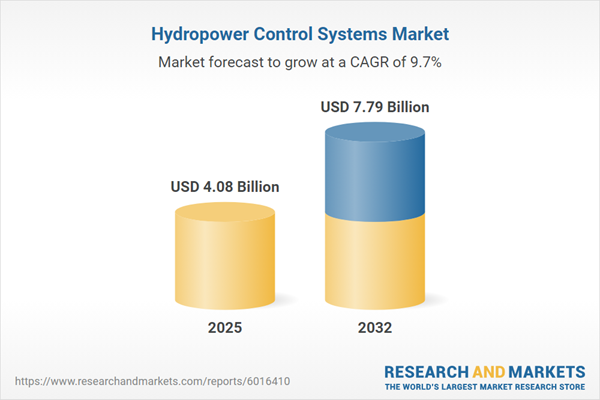Speak directly to the analyst to clarify any post sales queries you may have.
Hydropower control systems are advancing rapidly, becoming essential to both operational efficiency and reliability within the power sector. Senior leaders engaged in infrastructure modernization and energy transition benefit from a close evaluation of these solutions, as control systems now transcend core functionality by driving performance gains and ensuring compliance with evolving standards.
Market Snapshot: Hydropower Control Systems Market Overview
The hydropower control systems market is in a phase of robust expansion, reflecting increased demand for advanced digital controls, integrated monitoring, and predictive analytics. This growth is fueled by plant modernization efforts, stringent grid requirements, and the drive to diversify renewable energy resources.
Scope & Segmentation
This report provides a comprehensive analysis of the hydropower control systems landscape, structured by technology, product, application, end-user, voltage, and regional dimensions. Key coverage areas include:
- Product Types: Governor control systems (electronic and hydraulic governors), remote terminal units, SCADA (cloud-based and on-premise solutions), and turbine monitoring systems.
- Turbine Categories: Francis, Kaplan, and Pelton turbines—each bringing specific control, regulation, and integration needs across power plants.
- Applications: Modernization initiatives (control system upgrades, performance enhancements), and new installations with turnkey system architectures.
- End User Segments: Independent power producers, industrial operators (manufacturing, mining, oil & gas), and utilities managing diversified portfolios.
- Voltage Levels: High, medium, and low voltage networks shaping system specifications and component requirements.
- Regional Focus: Americas (North America, Latin America), Europe, Middle East & Africa, and Asia-Pacific—each with unique regulatory climates and infrastructure maturity.
- Market Players: Major companies featured include Andritz AG, Voith GmbH & Co. KGaA, General Electric Company, Siemens AG, ABB Ltd, Schneider Electric SE, Emerson Electric Co., Mitsubishi Electric Corporation, Hitachi, Ltd, and Rockwell Automation, Inc.
Key Takeaways for Decision-Makers
- Hydropower control systems now integrate advanced electronics, cloud platforms, and predictive tools. Operators benefit from increased flexibility and actionable diagnostics across legacy and new assets.
- Modern SCADA and supervisory systems support remote asset management, resilience, and compliance, transforming data into operational insights for proactive maintenance and grid alignment.
- Industry-wide collaboration involving manufacturers, technology partners, and research institutions accelerates innovation, adoption, and standardization, leading to improved interoperability and deployment speed.
- Regulatory and cybersecurity requirements increasingly inform system architecture, adding robust protection and ensuring alignment with regional grid codes for both new and retrofitted facilities.
- Segment-specific differentiation, such as turbine type or industrial verticals, allows for targeted solutions that maximize utility and support diverse project scopes, from small retrofits to complex new builds.
Tariff Impact: U.S. Supply Chain and Sourcing Strategies
Recent tariff measures in the United States have recalibrated sourcing and procurement processes for hydropower control equipment. As import duties affect international component flows, companies are diversifying suppliers, considering domestic alternatives, and optimizing inventory. This shift has elevated interest in modular system architectures and firmware upgrades, reducing capital risk while improving long-term asset value. Suppliers are responding by establishing regional hubs and streamlining distribution, supporting compliance with updated trade classifications. End users are performing comprehensive cost analyses to ensure optimal efficiency and performance over system lifecycles.
Methodology & Data Sources
Research for this report utilized structured interviews with system integrators, OEMs, regulators, and end-users to gather direct market insights. These perspectives were validated by consulting technical white papers, regulatory filings, and industry standards. Segmentation and analysis frameworks ensured robust and unbiased market mapping.
Why This Report Matters
- Offers actionable insights for navigating technology selection, regulatory challenges, and modernization priorities across global markets.
- Provides segment-specific intelligence aligned with current operational and compliance trends, supporting strategic investment and risk mitigation.
- Enables benchmarking of leading players and solution types to inform procurement, development, and partnership decisions.
Conclusion
Hydropower control systems are advancing in capability, flexibility, and strategic importance. Stakeholders equipped with detailed, segment-focused intelligence are best positioned to optimize technology investments and secure lasting operational performance in a changing regulatory landscape.
Additional Product Information:
- Purchase of this report includes 1 year online access with quarterly updates.
- This report can be updated on request. Please contact our Customer Experience team using the Ask a Question widget on our website.
Table of Contents
3. Executive Summary
4. Market Overview
7. Cumulative Impact of Artificial Intelligence 2025
Companies Mentioned
The companies profiled in this Hydropower Control Systems market report include:- Andritz AG
- Voith GmbH & Co. KGaA
- General Electric Company
- Siemens AG
- ABB Ltd
- Schneider Electric SE
- Emerson Electric Co.
- Mitsubishi Electric Corporation
- Hitachi, Ltd
- Rockwell Automation, Inc.
Table Information
| Report Attribute | Details |
|---|---|
| No. of Pages | 189 |
| Published | November 2025 |
| Forecast Period | 2025 - 2032 |
| Estimated Market Value ( USD | $ 4.08 Billion |
| Forecasted Market Value ( USD | $ 7.79 Billion |
| Compound Annual Growth Rate | 9.6% |
| Regions Covered | Global |
| No. of Companies Mentioned | 11 |









